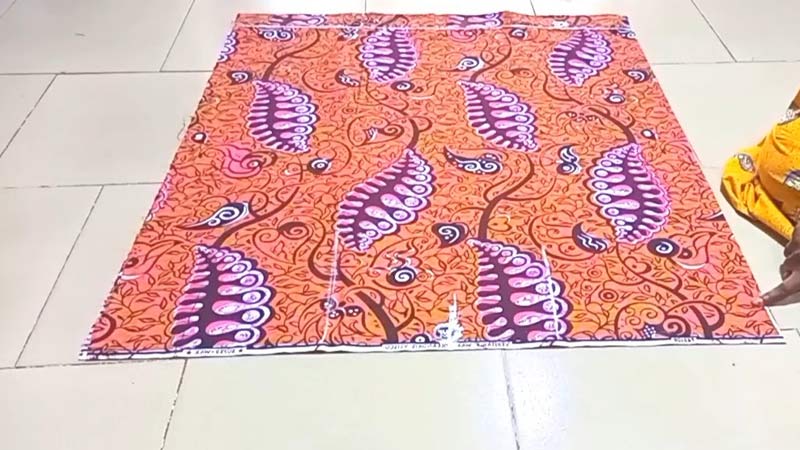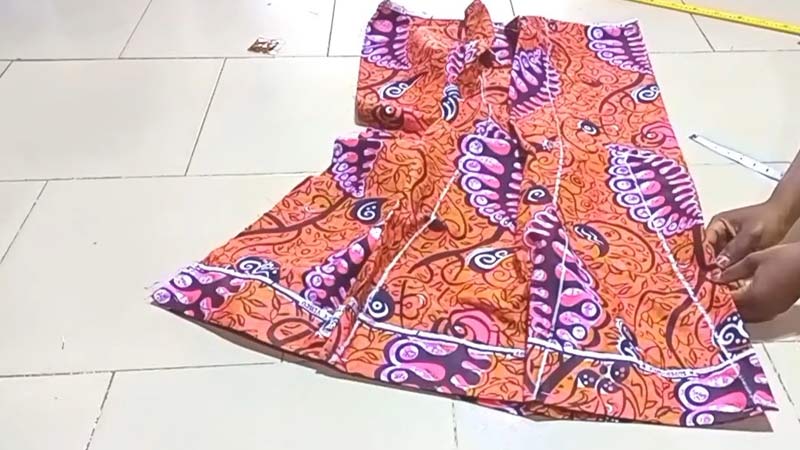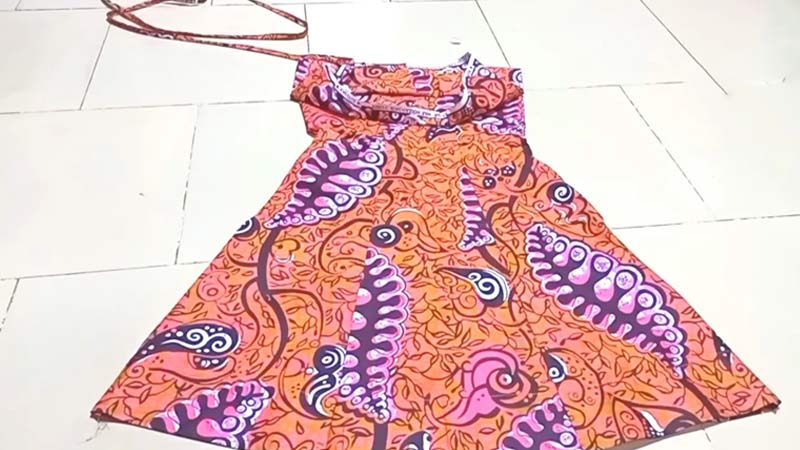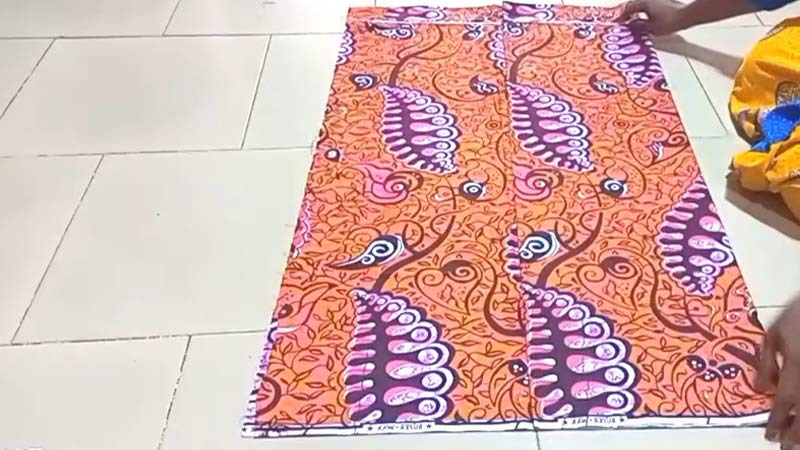Creating a stylish dress with just 2 yards of fabric is a testament to the art of efficient and budget-friendly sewing.
This endeavor demands careful planning, from selecting the right pattern and fabric to choosing a complementary style that suits both your physique and the available materials.
Whether you’re a seasoned seamstress or a novice, this guide will unveil the intricacies of maximizing a limited fabric resource.
Each step, from pattern selection to final fitting, will be dissected to ensure that your two-yard masterpiece reflects your personal style and sewing prowess. Embark on this creative journey to craft a dress that’s as unique as it is resourceful.

What Is 2 Yards of Fabric?
Two yards of fabric refer to a piece of textile material that measures 72 inches (or 6 feet) in length and typically 44 to 60 inches in width, depending on the fabric type and manufacturer.
This quantity of fabric is commonly used for various sewing and crafting projects, ranging from clothing and accessories to home decor items like curtains, pillow covers, and tablecloths.
It’s a versatile amount, suitable for many purposes, and often available in a wide range of colors, patterns, and textures.
Two yards of fabric can be sufficient for smaller garments, skirts, tops, or children’s clothing.
Its compact size also makes it convenient for storage and transportation, making it a popular choice for both beginners and experienced sewers.
How to Make a Dress With 2 Yards of Fabric?
Making a dress with just 2 yards of fabric can be a fun and budget-friendly sewing project.
Whether you’re a beginner or an experienced seamstress, this step-by-step guide will help you create a stylish dress with limited fabric. Before you begin, make sure you have the necessary sewing supplies:
Materials
- 2 yards of fabric (cotton, linen, and jersey are great options for beginners)
- Sewing machine
- Matching thread
- Scissors
- Pins
- Measuring tape
- Marking chalk or fabric pen
- Iron and ironing board
Here Is the Step-By-Step Guide for You:
Step 1: Choose a Pattern

When selecting a pattern, consider your skill level. For beginners, opt for patterns labeled as “easy” or “beginner-friendly.” These often have fewer pieces and straightforward instructions. Advanced sewers can explore more intricate patterns with details like pleats, darts, or intricate necklines.
Step 2: Prepare Your Fabric
Washing and ironing your fabric is essential. Use a gentle cycle and cold water to wash, and avoid using fabric softeners as they can affect the fabric’s texture.
Once washed, hang the fabric to dry or lay it flat to avoid stretching. Ironing is crucial to remove wrinkles and create a smooth surface for cutting and sewing.
Step 3: Cut Out the Pattern Pieces
Take your time laying out the pattern pieces on your fabric. Pay close attention to the grainline markings and any directional prints to ensure your dress hangs correctly.
Use fabric weights or pins to secure the pattern pieces in place before cutting. Cutting accurately is crucial to ensure your dress fits as intended.
Step 4: Sew the Seams
When sewing the seams, be mindful of the seam allowance specified in your pattern’s instructions. The standard seam allowance is 5/8 inch, but some patterns may vary.
Use the appropriate stitch length for your fabric type; shorter stitches work well for lightweight fabrics, while longer stitches are suitable for heavier fabrics.
Step 5: Create the Neckline and Armholes
Creating a neat neckline and armhole finishes adds a professional touch to your dress.
You can use bias tape, facing pieces, or even a lining depending on your pattern and fabric choice. Take your time to press the fabric at each step, ensuring the edges are crisp and clean.
Step 6: Finish the Hem
Hemming is often one of the final steps in dressmaking. A well-executed hem makes a significant difference in the overall appearance of your dress.
For a more polished look, consider using a hemming foot attachment on your sewing machine, which helps create even, narrow hems.
Step 7: Add a Closure (if necessary)
If your dress pattern requires a closure, such as a zipper or buttons, follow the instructions carefully.
Zippers should be installed evenly and securely, and buttons should align correctly. Take the time to make any necessary adjustments to ensure the closure functions smoothly.
Step 8: Final Press and Finish
After completing the main construction, thoroughly press your dress one more time. Pay attention to seams, hems, and any other details to ensure they lie flat and look professionally finished.
Step 9: Try On and Adjust
Trying on the dress at this stage is crucial to ensure a good fit. If the dress is too tight or loose, consider making alterations to the seams or darts.
Additionally, check the length to ensure it’s comfortable and suits your style.
Step 10: Enjoy Your New Dress
Once you’re satisfied with the fit and finish, you can proudly wear your handmade dress. Don’t forget to share your accomplishments with friends and family.
As you gain experience, you can experiment with different fabrics, styles, and embellishments to create unique and personalized dresses. Happy sewing!
Why Sew With 2 Yards of Fabric?

There are many reasons why you might want to sew with 2 yards of fabric or less.
Here are some of them:
Cost-Effective
Sewing with 2 yards of fabric is often more affordable than larger projects because you’re purchasing a smaller quantity of material.
This can be especially helpful for sewers on a budget or those who want to experiment with different fabrics without a significant financial commitment.
Stash Busting
If you’re an avid sewer, you may accumulate fabric scraps and remnants over time. Using 2 yards of fabric for a project is an excellent way to reduce your fabric stash and prevent unused materials from taking up space.
Quick Projects
Life can be busy, and finding time for sewing can be challenging. Choosing projects that require only 2 yards of fabric means you can complete them more quickly, providing a sense of accomplishment and allowing you to enjoy the fruits of your labor sooner.
Variety
Limited fabric quantities can spark your creativity. You might need to modify patterns, combine fabrics, or add unique design elements to make the most of what you have. This limitation often leads to more interesting and original garments.
Practice
If you’re new to sewing, starting with smaller projects is a practical way to build your skills.
You can work on essential techniques like cutting, sewing straight seams, and finishing edges without feeling overwhelmed by a large, complex project.
Eco-Friendly
In an era of environmental consciousness, using smaller amounts of fabric contributes to a more sustainable sewing practice.
It reduces fabric waste and lessens the demand for new materials, aligning with the principles of eco-friendly crafting.
Travel and Versatility
Smaller fabric pieces are portable and versatile. You can take your sewing projects with you on vacations, weekend getaways, or even during your daily commute if you enjoy hand sewing or embroidery.
Gifts and Personalization
Handmade gifts are thoughtful and often cherished by recipients.
With 2 yards of fabric, you can create personalized clothing or accessories tailored to the recipient’s style and preferences, making your gifts even more special.
What Kind of Dresses Can You Sew With 2 Yards of Fabric?

You can create a variety of dresses with 2 yards of fabric, depending on the style, length, and complexity of the design.
Here are some types of dresses that are suitable for sewing with this amount of fabric:
Shift Dress
A shift dress is a timeless and versatile choice. It’s typically sleeveless, has a straight silhouette that skims the body, and often features a simple neckline.
With 2 yards of fabric, you can create a casual, knee-length shift dress or add more fabric for a longer version.
This style is perfect for beginners and can be customized with various necklines and embellishments.
A-line Dress
A-line dresses are universally flattering. With 2 yards of fabric, you can sew a classic knee-length A-line dress or opt for a shorter or longer version depending on your preferences.
The A-line shape allows for comfort and ease of movement, making it suitable for both casual and semi-formal occasions.
Wrap Dress
The wrap dress is known for its timeless elegance and adjustable fit. With 2 yards of fabric, you can create a short or knee-length wrap dress.
This style is incredibly versatile and can be dressed up or down, making it a wardrobe staple.
Sundress
Perfect for warm weather, sundresses are typically sleeveless with a relaxed fit. With 2 yards of fabric, you can make a breezy sundress that’s ideal for picnics, beach outings, or casual gatherings.
Consider using lightweight and breathable fabrics like cotton or linen.
Tunic Dress
Tunic dresses offer a comfortable and relaxed fit. With 2 yards of fabric, you can create a tunic dress that falls to mid-thigh or knee-length.
These dresses are great for pairing with leggings, making them suitable for both casual and athleisure wear.
Babydoll Dress
Babydoll dresses have an empire waist and a loose, flowy fit. A 2-yard piece of fabric is sufficient to sew a short and sweet babydoll dress.
This style is playful and youthful, making it a great choice for casual outings.
Maxi Dress
Maxi dresses are long and flowing, perfect for more formal occasions or for creating a bohemian summer look.
With 2 yards of fabric, you can sew a sleeveless or short-sleeved maxi dress that reaches the ankles, ideal for warm-weather events.
How to Choose the Right Pattern, Fabric, and Style for Your Dress?

When sewing with 2 yards of fabric or less, you need to be careful about choosing the right pattern, fabric, and style for your project.
Here are some tips to help you:
Pattern
Choose a simple pattern. The more complicated the pattern, the more fabric you’ll need.
Avoid patterns that have a lot of pieces, seams, darts, pleats, gathers, or ruffles. Look for patterns that have a few pieces, simple shapes, and minimal details.
Fabric
Choose a wide fabric. The wider the fabric, the more you can fit on it. Look for fabrics that are at least 45 inches wide, or even better, 60 inches wide.
Choose a lightweight fabric. The heavier the fabric, the more bulky it will be.
Look for fabrics that are thin, soft, and drapey, such as cotton, linen, rayon, or silk. Avoid fabrics that are thick, stiff, or bulky, such as denim, wool, or corduroy.
Style
Choose a solid or small print fabric. The more patterned the fabric, the more you’ll have to match it. Look for fabrics that are solid or have a small print that doesn’t need to be aligned.
Avoid fabrics that have a large print, stripes, plaids, or checks that need to be matched.
FAQs
While you have flexibility in choosing styles, it’s essential to opt for simpler designs with fewer details to maximize fabric efficiency.
Lightweight and drapey fabrics like cotton, linen, rayon, and silk work well. Avoid heavy or bulky materials that consume more fabric.
Yes, you can sew formal dresses, but consider styles that are less elaborate and use minimal fabric to maintain an elegant look.
Choose styles that suit your body type, and always make a muslin or practice garment to adjust the fit before cutting into your final fabric.
You can add embellishments like lace, embroidery, or pockets to make your dress unique. Additionally, consider creative fabric combinations or color blocking for added flair.
To Wrap Up
In the realm of sewing, crafting a dress with just 2 yards of fabric exemplifies ingenuity and resourcefulness.
This journey from pattern selection to final fitting showcases the art of efficiency, where less truly becomes more.
By adhering to guidelines that favor simplicity, appropriate fabric choices, and styles that complement both the material and your body, you can transform limited resources into a stunning garment.
This creative process not only hones your sewing skills but also encourages personal expression through unique design elements and imaginative fabric combinations.
As you embark on future sewing adventures, remember that a mere 2 yards can yield a world of possibilities in the realm of fashion creation.
Leave a Reply